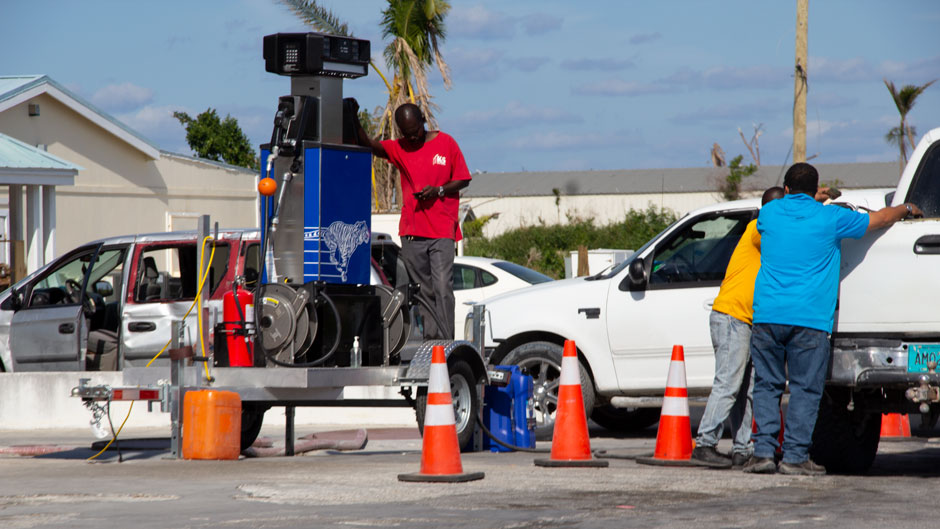Just days after Hurricane Dorian lashed the northern Bahamian islands of Grand Bahamas and Great Abaco, University of Miami doctors seasoned in disaster relief connected with the Bahamas Ministry of Health.
Dr. Barth A. Green, a neurosurgeon who is executive dean for global health and community service at the Miller School of Medicine, and Dr. Elizabeth Greig, an internist who worked with Green nearly a decade ago to coordinate the University’s response to the devastating earthquake in Port-au-Prince, Haiti, again jumped in to assess the health care needs in the Bahamas through a newfound partnership with Dr. Duane Sands, minister of health for the Bahamas.
Over numerous conversations during the next several months, and after a number of assessment trips to several islands, it was clear the recovery will take months, if not years. University leadership, led by Hilarie Bass, chair of the Board of Trustees, visited Marsh Harbour on Great Abaco Island on Sept. 22 and told Sands the University will be there for the Bahamian people.
This week the first physician from the Miller School of Medicine is in Marsh Harbour to assist health professionals at the Marsh Harbour Healthcare Centre, the primary health clinic for the Abaco islands and remote cays.
The following are some of the sights and sounds happening on an island beginning its rebirth from the harrowing impacts of Dorian, which struck Abaco on Sept. 1.
Thursday, Dec. 5
Marsh Harbour, The Crossings

The signs begin miles out from The Crossings, a narrow spit of land surrounded by water outside of Marsh Harbour’s downtown. Free Drinking Water. Since early October, Dominique Nannings has been manning the outpost provided by Water Mission, a nonprofit engineering organization that brings safe drinking water to disaster areas and developing countries.
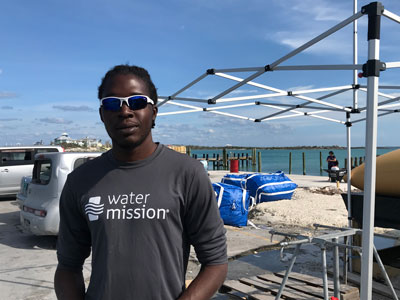
Inside a corrugated metal container, the continuous hum of a small desalination plant fills the quiet afternoon. Tubes and flexible pipes bring water from the sea into the engineering marvel, and the clean water flows into two huge rubber bladders that each hold 2,500 gallons of drinking water. Nannings is there during the day to help folks fill containers with the cleaned water, but the spigots are available 24 hours a day. About 8,000 to 9,000 gallons are filtered daily, and the need is great.
“Honestly, I am thankful to have this job, and I’m grateful for this chance,” said Nannings, who added that he hopes one day to be an engineer.
Nannings hunkered down in his house during Dorian with more than a dozen family and friends, and when the storm surge brought rising waters, they all pushed through a hatch leading to the attic. A young boy went through first, discovering part of the roof had been blown away. They all followed and huddled in a corner of the attic that remained covered.
Much like Miamians tell time by Hurricane Andrew—“it happened before Andrew,” or “it happened after Andrew”—the people of Abaco are beginning to use the reference. “I was with a friend the other night, and he said, ‘You know, we will be telling our grandchildren about Hurricane Dorian.’”
“I’m waiting for my island to come back,” Nannings said.
Thursday, Dec. 5
Marsh Harbour Healthcare Centre
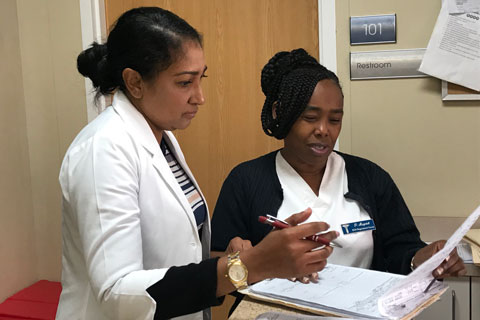
Dr. Indira Jones reviews patient information with registered nurse Pauline Maycock.
Like Dr. Paul Wetstein, a trauma surgeon from the University of Miami Miller School of Medicine, Dr. Indira Jones arrived at Marsh Harbour on Monday, Dec. 2. A medical officer with the Bahamas Ministry of Health, she was deployed from her home base in Nassau.
About a dozen employees of the Ministry’s Community Health Service are working at the Marsh Harbour Healthcare Centre, rotating out crews each week. They all live at the heath center in a maternity ward that have been converted to living quarters. Patients, Jones said, are being treated for hypertension, one of the most common ailments associated with the post-Dorian recovery, the common cold, and asthma that has been exacerbated by the levels of mold that grew in many of the homes that had been flooded during Dorian. The clinic is open 24 hours a day and will never turn anyone away. More serious emergencies are transported to Nassau for intensive care treatment.
The team also provides health care visits or telephone assistance to clinics in many of the outlying cays and remote areas, including Guana Cay, Moore’s Island, Treasure Cay, Sandy Point, and Hope Town. “We are seeing more people now because more people are coming back,” Jones said. “It’s going to get back to where it used to be, but it’s going to take time.
“The island people, they love their home. They are optimistic. They have Abaco, they are not going anywhere. It’s home for them.”
Thursday, Dec. 5
Marsh Harbour Healthcare Centre
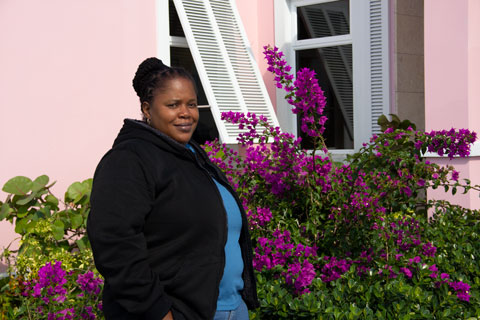
Tracey Albury, a medical records clerk who was born and raised on Great Abaco Island, was at her home in Murphy Town, just north of Marsh Harbour, when Dorian swept in. Five houses filled her block. After Dorian, just two remained, including hers.
First, the kitchen roof blew off. Then the bedroom roof went missing. Water was coming up, and the rain was pouring down. She and her husband, John, decided to flee to a shelter. When they arrived, the shelter’s roof came off. They continued on to a nearby church but were stopped when a tree crashed across the road in front of them, maybe a few hundred yards short of the church. Fighting the wind and rain, they made their way to the shelter, but not before the harrowing experience of having the roof of a house fly over Tracey’s head. They spent the next three days at the church, and then moved in with John’s boss until they could get a tarp over the roof of their house.
“We lost everything. Everything,” Albury said. “Furniture. Our bed. Clothes. My house was like someone came in and ‘cleaned house.”’ She said she has talked to a psychologist about the experience and was told it was beneficial to talk about her experiences. But even now, at night, the hurricane nightmare “keeps playing back, over and over again. Some people watched the hurricane from inside. We were out there in it.”
The future, however, looks bright, Albury said. Some gas stations and grocery stores have reopened, a positive first step toward normalcy.
“It makes me feel good. It gives me hope that it’s all coming together,” she said. “Eventually we are going to bounce back. That’s what we say. We’re going to bounce.”
Thursday, Dec. 5
Marsh Harbour waterfront area
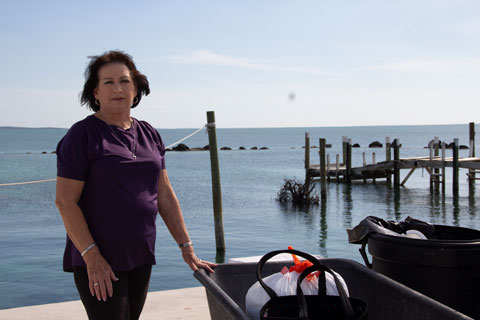
It was after midday and Janice Sawyer was waiting at the docks for the ferry to take her to Guana Cay just to the north of Marsh Harbour, where she was now back at work three days a week at the offices of a construction company. She returned Wednesday, having bounced around since she and her husband survived Dorian between stints on Eleuthera Island and in West Palm Beach, Florida. “My house,” she exclaimed with exasperation. “I’ve got a lot of cleanup to do.”
The day of Dorian, Sawyer, her husband Jay, and her 85-year-old mother were in their house in Marsh Harbour, watching the winds whip around and the waters begin to rise, even though they lived a mile inland from the coast. “A wave rose up and just came through the living room window,” she said. They knew they had to get out, thinking a house nearby that was on higher ground would be a better place to wait out the storm.
Jay climbed out a window and hoisted her mother on his back and swam to the other house. He came back for his wife and repeated the process.
“It was like a horror movie,” she said. “The water came so fast. If that had come through at night, we all would have drowned because we wouldn’t have been able to see anything.”
Sawyer is staying at her brother’s house for the short term as they try to repair their home. “It’s very discouraging,” she said, “but Abaco people are really strong. This is going to take a long, long time.”
Wednesday, Dec. 4, late afternoon
Marsh Harbour Healthcare Centre
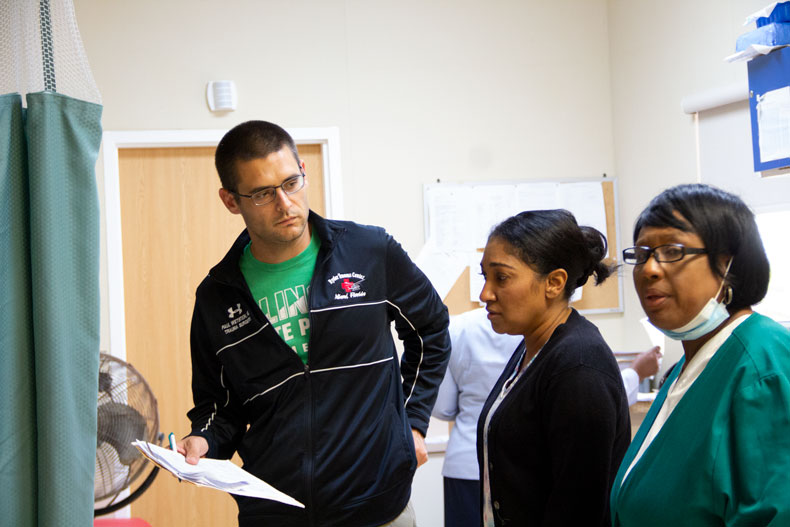
It was late afternoon on Wednesday, near the end of his shift, when Dr. Paul Wetstein, a Miller School of Medicine physician working as a trauma surgeon at the Ryder Trauma Center at Jackson Memorial Hospital in Miami, turned to his colleague at the Marsh Harbour Healthcare Centre. “We have an emergency,” he told Dr. Indira Jones, who has relocated from Nassau to help out at the clinic.
A middle-aged man had walked into the clinic requesting a physical he needed for a job. He also wanted a refill of some medication for high blood pressure. As part of the exam, nurses took his blood pressure, finding it to be twice as high as normal, placing the man in grave danger of a debilitating stroke. He was immediately given intravenous medication and would later be airlifted to an intensive care unit in Nassau for continued observation.
“He just came in for a routine visit and to get a refill,” Wetstein said. “He could have had a stroke.”
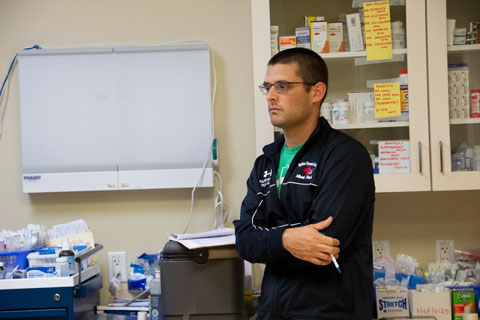
As people who were evacuated return to Marsh Harbour, the health clinic is seeing more and more people who have let their medications lapse since the hurricane. Many of the patients now are looking to restart medications for high blood pressure and diabetes.
Of the 40 or so patients the clinic is seeing daily now, Wetstein said, about 80 percent are seeking primary care, with about 20 percent involving emergency care. Construction accidents are becoming more common as the rebuild gets underway: Wetstein this week treated a man who injured three fingers in a rotary belt machine accident, another man who fell from some roof rafters, another who pierced an extremity with a nail, and several people who had accidentally injured themselves with hammers.
Babies and young children are being brought in for well care visits. The clinic has a midwife on the team who attends to any maternity cases. The clinic also houses a pharmacy, and a lot of people are stopping by for medications.
Wetstein is a second-year trauma critical care fellow, and an active duty officer, a major, in the U.S. Army, to which he enlisted in 2008. Originally from Illinois, he went to undergraduate school at the University of Illinois and received his medical degree from Uniform Services University in Bethesda, Maryland. He spent six years at the Tripler Army Medical Center in Honolulu, Hawaii, before coming to Miami a little less than two years ago.
The Midwesterner had never been to the Bahamas before, had never experienced a hurricane, and had never seen first-hand the damage a major cyclone can produce. After arriving at Marsh Harbour Monday, a worker with the ministry of health drove him around the town to see the aftermath before taking him to the health clinic.
“I was shocked,” Wetstein said. “It truly looked like pictures of a war zone.” As a trauma surgeon, though, this is the type of work for which he has been trained. “I want to be at ground zero when people need help.”
Wetstein said the warmth of the Bahamian people is palpable.
“They are appreciative and so welcoming,” he said. “They are grateful for the services we are providing. The nurses and doctors are great to work with. We are learning from each other, 100 percent. But mostly, I am learning from them.”
Wednesday, Dec. 4
Marsh Harbour Healthcare Centre
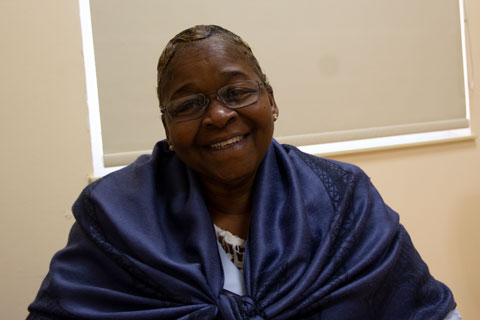
Deborah Fox, senior nursing officer at the Bahamas Ministry of Health, spent the days during Dorian’s approach to the Bahamas in late August hunkered down in the Ministry of Health’s emergency command center in Nassau. Dorian hit Abaco on Sept. 1 and moved on to Grand Bahama and its largest city, Freeport, on Sept. 2 and Sept. 3. The first damage reports came from Rand Memorial Hospital in Freeport, with patients being evacuated after storm surge waters flooded the building.
“We knew the injuries would be insurmountable, and we thought there would be loss of life,” she recalls. The team began figuring out where they could set up morgues to handle the bodies. One of the morgues was established in the Marsh Harbour Healthcare Centre. The official death toll from Dorian is about 65, but many more remain missing.
Fox came to Marsh Harbour on Nov. 25 to help out at the health clinic. Before then, she had only read about the damage and seen photographs. Experiencing it firsthand, she said, was an “Oh my! experience” for her.
“I couldn’t believe the devastation,” she said. “The buildings were destroyed like they were made of paper. It was a humbling experience for me.”
Wednesday, Dec. 4
Leonard M. Thompson International Airport, Marsh Harbour
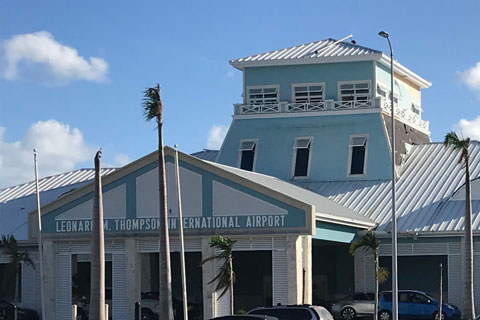 The ATR 42 twin-turboprop operated by Bahamasair, the national airlines of the Bahamas, taxied toward the terminal after the short hop from the capital of Nassau, on New Providence. The flight was nearly full, bringing tourists, residents, and a much-needed workforce that will help the island rebuild. A young man who grew up in Nassau and is trained in heavy equipment operations, was beginning a new job. He wasn’t sure how long he would be there—weeks, but perhaps months, he said. Temporary housing and meals would be provided.
The ATR 42 twin-turboprop operated by Bahamasair, the national airlines of the Bahamas, taxied toward the terminal after the short hop from the capital of Nassau, on New Providence. The flight was nearly full, bringing tourists, residents, and a much-needed workforce that will help the island rebuild. A young man who grew up in Nassau and is trained in heavy equipment operations, was beginning a new job. He wasn’t sure how long he would be there—weeks, but perhaps months, he said. Temporary housing and meals would be provided.
The terminal building still wore the scars from Dorian—flashing torn from the rafters, missing shingles, and piles of debris from damaged buildings, vehicles, and felled timber sat nearby. But inside, the building was teeming with activity as families reunited and other connections were made. Outside, a line of taxis waited to take people to their destinations, and other cars and trucks maneuvered around the flow of people and vehicles. When University leadership visited on Sept. 22, the airport was empty, guarded by police and soldiers.
But along the Great Abaco Highway leading from the airport and the main thoroughfare of S.C. Bootle Highway, Dorian’s wrath was plainly evident. Much work remains to be done.
“We’re doing a little better every day,” one man said.
There is a buzz of a new beginning occurring. People walking on the side of roadways. More traffic on the streets. Fluttering flags announcing places open for business.
